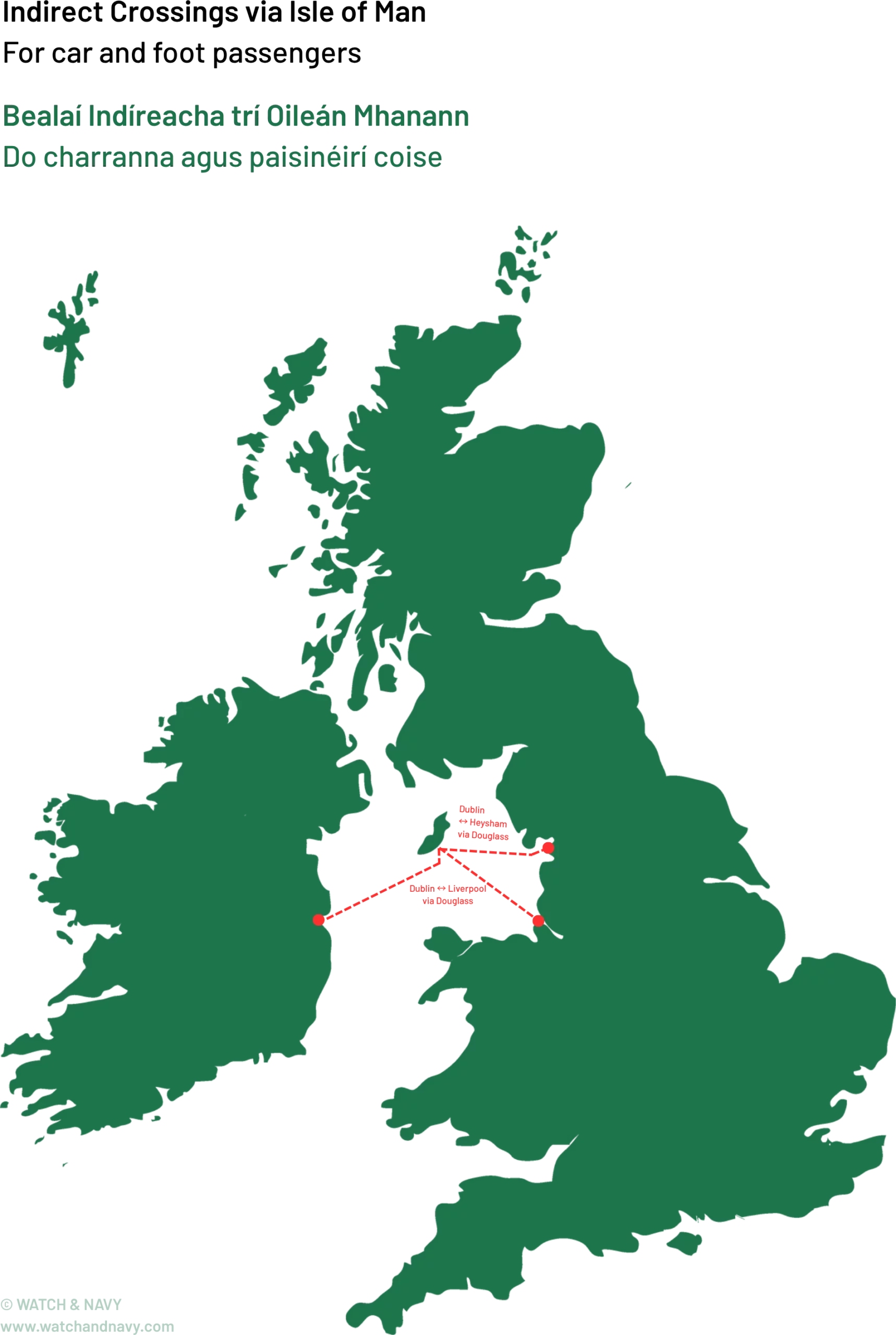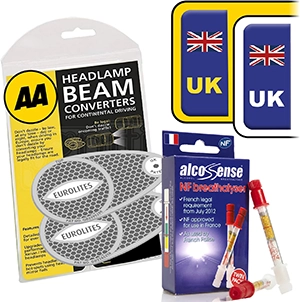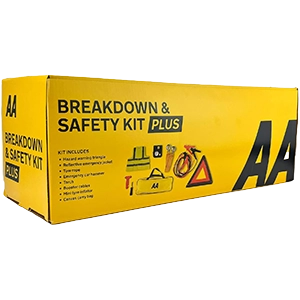Travelling from Britain to Ireland by car is a journey filled with promise: open roads, rolling green hills, coastal villages, and two nations offering rich culture and hospitality. Whether you are heading for a weekend city break or planning to explore the Wild Atlantic Way at your own pace, taking your own vehicle offers a freedom no plane or train can match.
However, crossing the Irish Sea requires more preparation than simply booking a ticket and turning up. Each part of the trip, from selecting the right ferry route to understanding insurance rules, needs a little forward planning. Different jurisdictions, currencies, driving laws, and post-Brexit travel changes all play a role in shaping your trip.
Without the right information, even simple issues like missing paperwork or an overlooked insurance requirement can cause unnecessary headaches. Fortunately, with a bit of care, the process is straightforward, and the rewards are considerable.
This guide will walk you through everything you need to know about crossing from Britain to Ireland by car. From choosing ferry routes to preparing your documents and understanding what changes when you cross the border between Northern Ireland and the Republic, you will be fully equipped to enjoy a stress-free and memorable journey.
- Choosing Your Ferry Route: Crossing Points Explained
- Preparing for the Crossing
- Understanding the Challenges of Cross-Border Driving
- Adapting to Driving in Ireland
- Border Crossings Between Northern Ireland and the Republic
- Travel Tips for a Smooth Journey
- Essential Vehicle Checks Before Your Journey
- Enhancing Your Driving Experience in Ireland
- Safe Travels
- Save the Memory with Velocity GPS Dashboard
Choosing Your Ferry Route: Crossing Points Explained

The sea crossing from Britain to Ireland is straightforward, but choosing the right route can make a big difference to your journey. Ferry ports stretch across the west coast of Britain and link to key points across both Northern Ireland and the Republic. Some crossings are fast and direct; others offer quieter, less busy alternatives.
Major Ferry Routes and Ports
The busiest and most popular route is from Holyhead in Wales to Dublin Port. Ferries run frequently throughout the day, and the crossing takes around three hours. Irish Ferries and Stena Line both operate this route, offering a choice between standard ferries and faster catamaran options.
From Birkenhead (across the River Mersey from Liverpool), you can also sail directly to Belfast. These crossings tend to be longer, around eight hours and are often overnight sailings, ideal if you prefer resting during the journey.
Drivers heading to Northern Ireland often choose Cairnryan in Scotland. Ferries from Cairnryan serve both Larne and Belfast, with Stena Line and P&O Ferries offering multiple sailings per day. The crossing is short, typically around two hours, and puts you directly into Northern Ireland without crossing the land border.
In southwest Wales, Fishguard and Pembroke offer services to Rosslare, ideal if your destination is the south or west of Ireland. These are quieter routes, with fewer crowds, and are particularly convenient for exploring areas like Wexford, Cork, or Limerick.
Choosing the Right Route for You
When choosing your ferry, think about your starting point, your end destination, and your tolerance for driving vs sailing time. A longer drive to a faster ferry crossing (such as Holyhead–Dublin) may save you hours compared to a short drive and a long overnight crossing (such as Liverpool–Dublin).
| Route | Operators | Foot Passengers | Vehicles | Average Duration |
| Holyhead ↔ Dublin | Stena Line, Irish Ferries | ✔ | ✔ | 3h 15m, up to 3h 45m |
| Fishguard ↔ Rosslare | Stena Line | ✔ | ✔ | 3h 30m |
| Pembroke ↔ Rosslare | Irish Ferries | ✔ | ✔ | 4h 0m |
| Cairnryan ↔ Belfast | Stena Line | ✔ | ✔ | 2h 15m |
| Cairnryan ↔ Larne | P&O Ferries | ✔ | ✔ | 2h 0m |
| Liverpool–Birkenhead ↔ Belfast | Stena Line | ✘ | ✔ | 8h 00m |
Facilities onboard also vary. Ferries for longer and overnight routes tend to have cabins, restaurants, and lounges, while shorter crossings may simply offer basic seating and a café. If you are travelling with pets, young children, or prefer a little extra comfort, be sure to check ferry amenities before you book.
Booking in advance is strongly advised, especially during holiday periods or if travelling with a large vehicle or trailer. Some operators offer flexible tickets that allow you to change your booking without heavy fees, a useful option if your plans are not fully fixed.
Preparing for the Crossing

While driving in Ireland is straightforward once you are there, the crossing itself needs some thought. Ports across Britain operate slightly differently, and the process of boarding with a vehicle is not quite the same as boarding on foot or with hand luggage alone.
Getting Your Vehicle Ready
Before you leave, it is wise to give your car a quick health check. Check the tyre pressure, oil, coolant, and windscreen washer fluid. Ferry companies often recommend arriving with at least a quarter tank of fuel, especially if travelling at night when fewer petrol stations are open at the port.
If your number plate does not display a UK identifier, apply a UK sticker to the rear of your vehicle. Although ferry staff rarely check this in Britain, authorities in Ireland may request it. It is a simple way to avoid unnecessary questions at the dockside or after arrival.
If you are carrying roof boxes, bicycles, or trailers, check the ferry company’s size limits before you travel. Some vehicles require special bookings or attract additional charges if they are above standard height or length.
What to Bring and What to Expect
You will usually be asked to check in between 60 and 90 minutes before departure. Have your passport or ID card, ferry booking reference, and vehicle registration details ready. Most ferry operators now use QR codes or e-tickets, but a printed copy can be useful if your mobile signal fails.
On board, you will be asked to leave your vehicle and head to the passenger decks for the crossing. Make sure you take valuables, travel documents, and anything you will need for the next few hours. Once you leave the car deck, you cannot usually return until docking.
If you are travelling overnight, some crossings offer cabin bookings, while others have designated seating areas for those staying up. Booking a cabin in advance is recommended if you’d like a private space to rest, particularly on longer routes like Liverpool to Dublin.
Understanding the Challenges of Cross-Border Driving

Crossing from Britain to Ireland by car brings a unique blend of simplicity and complexity. While there are no lengthy customs queues between the two countries, you are still travelling between different jurisdictions, with separate laws, currencies, and driving practices to consider.
Different Rules in Northern Ireland and the Republic of Ireland
Northern Ireland is part of the United Kingdom. The Republic of Ireland is a sovereign EU country. Crossing from one to the other is straightforward; there are no passport checks at the land border, but differences are easy to miss if you are not prepared.
In Northern Ireland, road signs and speed limits use miles per hour (mph), the same as in Britain. In the Republic of Ireland, everything switches to kilometres per hour (km/h). If you miss the change, you could unintentionally break the speed limit. Always stay alert for signage when you cross.
Currency also changes. You will use Pounds Sterling (£) in Northern Ireland but Euros (€) in the Republic. Carry a small amount of each currency to cover tolls, parking, and rural areas where card machines may not work, even though contactless payments are widely accepted.

Northern Irish Banknotes
✅ Bank of England notes are also accepted everywhere in Northern Ireland.
💡 Some banks offer multi-currency accounts or travel cards that let you spend in both GBP and EUR with lower fees and better exchange rates. Consider setting one up before you travel; it could save you time and money.
Essential Documentation for Driving
Whether you’re driving your own vehicle or hiring one, you’ll need to carry the right paperwork. A full UK driving licence is valid throughout Ireland; you do not need an International Driving Permit unless you have a paper licence issued before 1998.
Vehicle insurance is where many drivers get caught out. Most UK policies extend to the Republic of Ireland, but not all. Some may require you to request a ‘Green Card‘, an internationally recognised proof of insurance. It’s best to confirm with your insurer in advance of travel. Carry your insurance documents and a passport or ID card as standard.
Vehicle Identification and Brexit Changes
Since Brexit, British drivers are required to display a UK identifier sticker on their vehicle if travelling outside the UK, including to Ireland. You don’t need an additional sticker if your number plate already shows the UK symbol with the Union Flag. However, if your plate shows GB or has a Euro symbol, a separate UK sticker is required.
Checking these small details before you travel can save a great deal of hassle later. Taking time to prepare means you can cross borders freely, focus on the drive, and enjoy the experience without last-minute surprises.
Includes 2 NF Certified AlcoSense Breathalysers, AA Eurolites Headlight Deflectors, and UK Number Plate Stickers for driving in France and Europe. Quick and easy compliance with simple instructions, ensuring safety and regulation adherence for your travels.
Adapting to Driving in Ireland
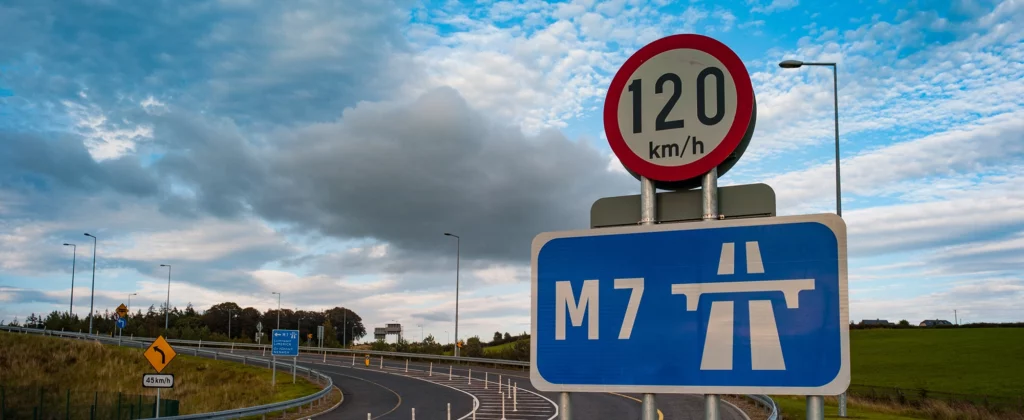
Once you and your vehicle have arrived safely in Ireland, the experience of driving is familiar in many ways, but there are important differences to be aware of. Preparing for these subtle changes will help you avoid fines, misunderstandings, or unnecessary stress on the road.
Adapting to Speed Limits and Road Signs
The most immediate difference after stepping off the ferry is the signage. In Northern Ireland, speed limits are displayed in miles per hour (mph), exactly as they are in Britain. However, once you enter the Republic of Ireland, all speed limits change to kilometres per hour (km/h).
Here’s a quick speed conversion chart for common speed limits you’ll encounter:

This switch can catch drivers off guard, especially when road conditions don’t feel different. Pay close attention to signs, especially when moving between motorway, national road, and local road networks, as the numbers may seem higher but represent different speeds.
Other signage differences include different layouts for junctions and slightly different warning symbols (for example, yellow diamond-shaped signs are common on rural roads in the Republic). It’s a good idea to set your car’s digital display to km/h if your vehicle allows it, at least while you are driving in the Republic.
Fuel Types, Road Tolls, and Practical Differences
Fuel stations in Ireland use slightly different labelling conventions.
- Fuel stations often label petrol as unleaded or simply petrol.
- Some fuel stations label diesel as either diesel or gasóleo, depending on the area.
Toll roads are also a feature of driving in Ireland, particularly around major cities. The M50 motorway around Dublin uses a barrier-free toll system, where your number plate is recorded automatically. You must pay the toll online by 8pm the following day, there are no physical booths. Other toll roads have standard cash or card payment booths.
Carrying small change or a debit card is useful, especially for unexpected tolls in rural areas where contactless payment might not always work.
Insurance and Breakdown Realities
Once you are on Irish roads, your insurance should provide the same level of cover as it does at home, assuming you checked your policy before travelling. If you do experience a breakdown or accident, it’s important to know that breakdown services can take longer to reach remote areas, particularly in the west of Ireland or rural Northern Ireland.
If you are using a rental car sourced in Ireland, many providers include basic breakdown cover automatically, but it’s worth checking if you need to add extended roadside assistance, especially if planning longer drives through remote areas.
Border Crossings Between Northern Ireland and the Republic
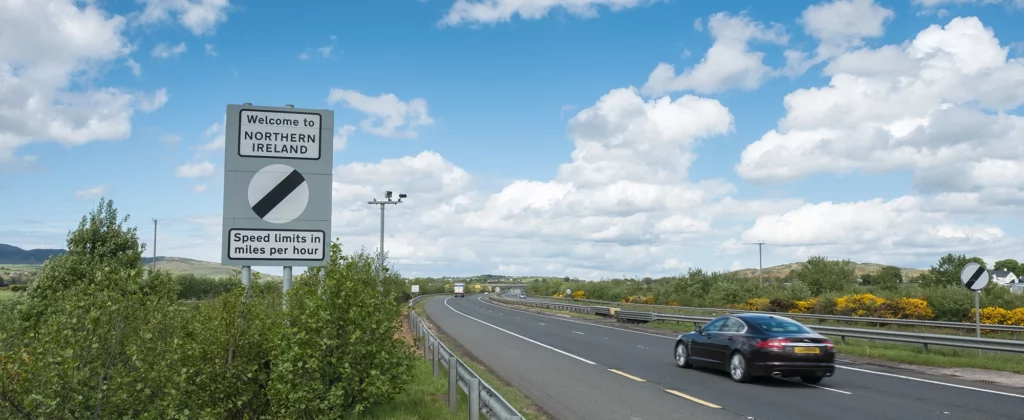
🇮🇪 Republic of Ireland – Northern Irish Border
Driving between Northern Ireland and the Republic of Ireland is refreshingly simple for motorists. Since the Good Friday Agreement, the border has been almost invisible. There are no checkpoints or customs posts, and most drivers cross without even noticing the change at first.
✳️ As of February 1, 2025, Non‑UK and non‑Irish nationals now need a UK Electronic Travel Authorisation (ETA) before travelling into Northern Ireland– even via the Republic. There are still no routine border controls on the island, but having an ETA is legally required.
No Physical Border, But Some Practical Differences
Although you will not be stopped when crossing, a few details change once you pass between jurisdictions. As mentioned earlier, speed limits switch between miles per hour and kilometres per hour. Road signs and road markings also vary slightly in style and language, with Irish (Gaeilge) often appearing alongside English in the Republic.
Phone roaming charges could also change at the border, depending on your network. While many providers include Ireland in UK roaming deals, it is worth checking to avoid surprise fees if your phone automatically switches.
Currency and Emergency Services
In Northern Ireland, you will continue using Pounds Sterling. In the Republic, you will need Euros. Some businesses near the border accept both currencies, but it is safer to assume that local shops, petrol stations, and toll booths expect payment in Euros once you have crossed.
Emergency numbers stay simple. Whether in Northern Ireland or the Republic, dialling 112 or 999 will connect you to the appropriate emergency services. This consistency means you do not have to worry about changing numbers depending on where you are.
🆘 Remember the local emergency numbers: Both 112 and 999 connect you to emergency services across the entire island of Ireland.
Crossing the border remains one of the smoothest parts of driving between Britain and Ireland, offering the freedom to explore without interruption. Being aware of the small differences ensures you stay relaxed and confident, whichever side you find yourself on.
Travel Tips for a Smooth Journey
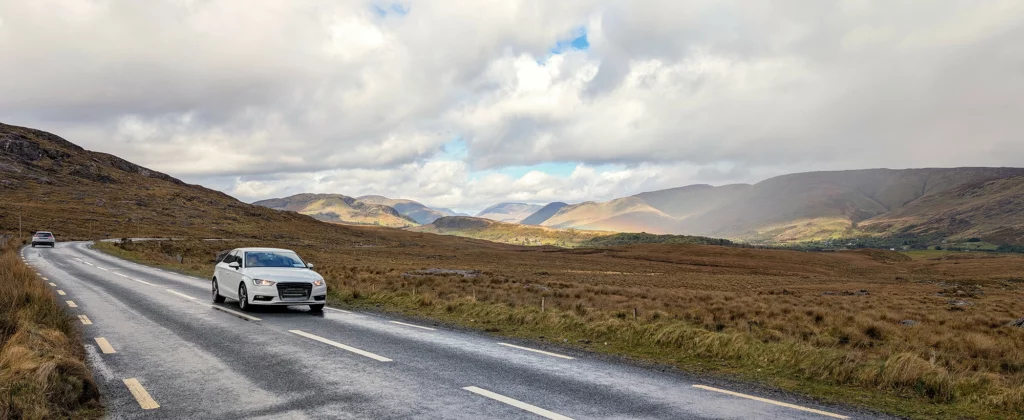
🇮🇪 Maum, County Galway, Ireland / An Mám, Contae na Gaillimhe, Éire
Planning ahead can make a real difference when driving between Britain and Ireland. The crossing itself is relatively simple, but small decisions around timing, booking, and preparation can set the tone for a much easier trip.
Timing Your Journey for Comfort and Safety
Where possible, choose sailings that align with good driving conditions. Early morning crossings are often less crowded, and seas tend to be calmer before midday. If you are a nervous sailor or travelling with young children, avoiding overnight crossings or peak weekend sailings can make the experience more relaxing.
Allow extra time for the drive to the ferry port. Traffic bottlenecks, particularly around cities like Liverpool or Holyhead, can cause unexpected delays. Arriving early is preferable to missing your departure window, especially during holiday periods when ferries operate at full capacity.
Keep a flexible attitude when travelling. Weather conditions can occasionally disrupt sailings, particularly in winter. Choosing flexible tickets, where possible, means you can adjust your plans if delays or cancellations occur without heavy penalties.
Accommodation and Stopovers
If your ferry crossing is early or late, booking accommodation near the port can take the stress out of your journey. Many port towns have budget hotels within a short drive of the terminals, and it is often more comfortable to rest properly before a long day of driving ahead.
In rural Ireland, accommodation options can be more limited, especially outside major cities. Booking ahead is advisable during peak travel seasons, particularly if you are venturing along the Wild Atlantic Way or other popular routes.
Maps, Apps and Navigation
Modern navigation apps work well across Britain and Ireland, but mobile signal can still be patchy in remote areas, particularly in rural parts of Wales, Scotland, and western Ireland. Download offline maps in advance or use a dedicated GPS device to avoid losing your route if signal drops.
It is a good habit to keep a printed map in the car as a backup, especially if you plan to explore more remote parts of the countryside where even downloaded apps can falter.
Essential Vehicle Checks Before Your Journey

Long drives and ferry crossings demand a little extra care when it comes to vehicle maintenance. A few basic checks before you leave home can make the difference between a smooth journey and avoidable delays at the roadside.
Tyres, Brakes and Fluids
Check your tyre pressures against the manufacturer’s recommendations, and inspect the tread depth to ensure it meets legal requirements. Under-inflated or worn tyres are not only dangerous, they can also affect fuel consumption and vehicle handling, particularly on wet rural roads.
Brakes should feel responsive without any vibration or noise. If in doubt, have them inspected by a professional before your trip. Remember that rural and hilly roads, particularly in western Ireland, will test your brakes more than city driving.
Top up all fluids before setting off: oil, coolant, and windscreen washer fluid are especially important. Make sure your battery is in good condition too, particularly if you are using a vehicle that has been standing idle for a while.
Lights, Mirrors and Visibility
Give all your lights a once-over before you travel. Headlights, brake lights, indicators and fog lights should be clean and working correctly. Dirt and salt from ferry decks or rural roads can quickly dull lights and mirrors, so it is worth carrying a cloth and cleaning spray for quick wipe-downs on the move.
Ensure your mirrors are adjusted correctly and are free from cracks or damage. Good visibility is essential, particularly in poor weather or on unfamiliar roads.
Emergency Kit Essentials
Carrying a few basic emergency items gives you peace of mind if something goes wrong. Essentials include a warning triangle, high-visibility jackets, a torch with spare batteries, basic first aid supplies, a jack and spare wheel, and jumper cables.
For longer journeys, consider adding extra drinking water, non-perishable snacks, and a portable power bank to keep your mobile devices charged if you are delayed.
A little preparation goes a long way, helping you to enjoy the journey across Britain and Ireland with confidence, whatever the road ahead may bring.
Stay prepared for roadside emergencies with this compact kit, including a warning triangle, reflective jacket, booster cables, tow rope, torch, emergency hammer, mini tyre inflator, and a durable carry bag.
Enhancing Your Driving Experience in Ireland
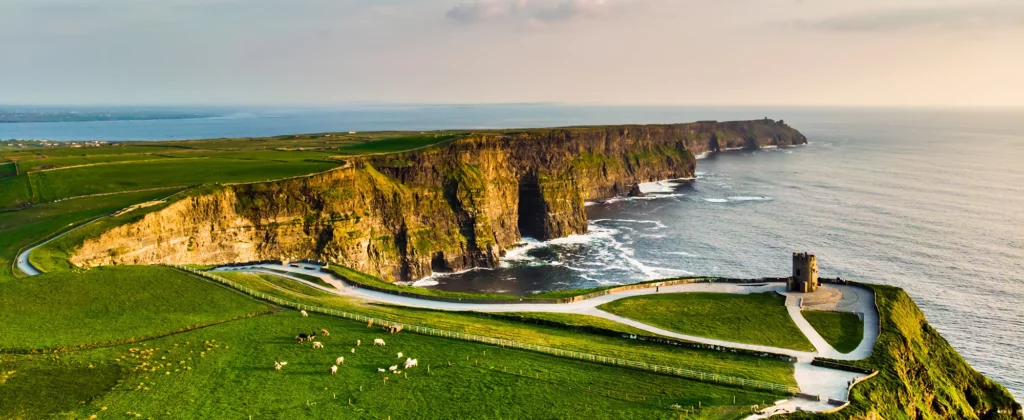
Driving across Britain and Ireland is more than a practical way to get from place to place. It is a chance to experience the varied landscapes and cultures of two different nations at your own pace. With a little extra preparation and a flexible attitude, you can turn a simple journey into a memorable road trip.
Embracing Scenic Routes
Ireland is well known for its scenic driving routes. The Wild Atlantic Way, stretching along the west coast of the Republic, offers winding roads, dramatic cliffs, and coastal villages. In Northern Ireland, the Causeway Coastal Route provides a spectacular drive between Belfast and Derry, taking in landmarks like the Giant’s Causeway and Carrick-a-Rede rope bridge.
If time allows, avoid sticking rigidly to motorways. Some of the best experiences come from exploring rural byways, scenic coastal loops, and stopping at local towns and villages along the way. Allow extra time in your itinerary for spontaneous stops, whether it is a beach, a local café, or a viewpoint over the hills.
Local Driving Customs and Courtesy
Driving habits in Ireland are generally relaxed, though rural roads can be narrow and winding. On single-track roads, use passing places to allow oncoming vehicles through, and offer a small wave or nod to acknowledge other drivers’ courtesies.
Be patient around farm traffic, especially during spring and autumn when tractors and livestock movements are common on country lanes. In towns and villages, watch for pedestrians and cyclists, who may use the road edge rather than designated paths.
Urban driving in Dublin, Belfast, or Cork can feel busier, with one-way systems and bus lanes requiring careful navigation. Always watch road markings closely, and do not be afraid to pull over safely to recheck your route if needed.
Safe Travels

“May the road rise up to meet you, May the wind be always at your back”
— Traditional Irish blessing 🍀
Crossing from Britain to Ireland by car opens up an extraordinary freedom to explore at your own pace. Whether you are venturing north to the Giant’s Causeway or south to the Ring of Kerry, preparing for the crossing properly sets you up for a smooth journey from the start.
From checking ferry routes and understanding borderless travel to adjusting to different speed limits and currency changes, a little groundwork goes a long way. Keep a flexible mindset, prepare your vehicle carefully, and enjoy the chance to take the road less travelled.
Wherever your journey takes you, safe travels, and enjoy the open road.
Save the Memory with Velocity GPS Dashboard
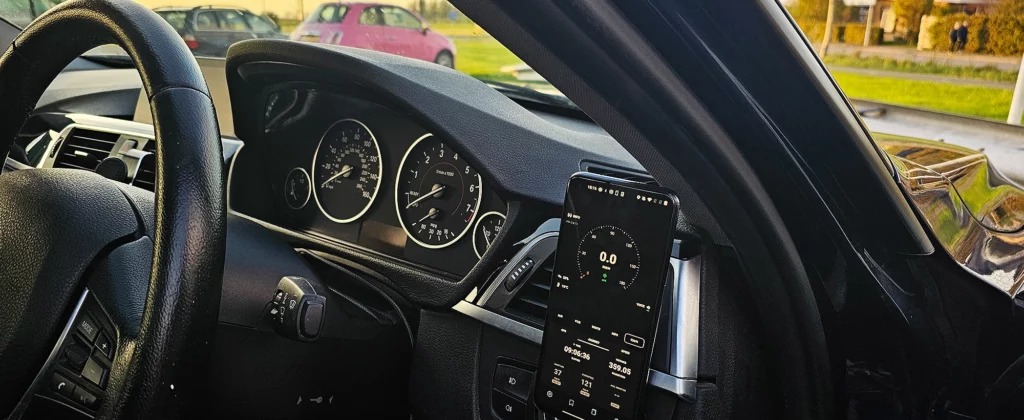
Make your trips more memorable. Record every detail with Velocity GPS Dashboard.
Learn more about Velocity GPS Dashboard and download on Google Play:

